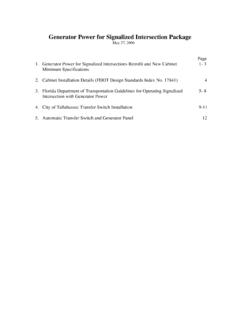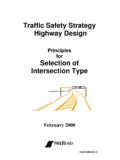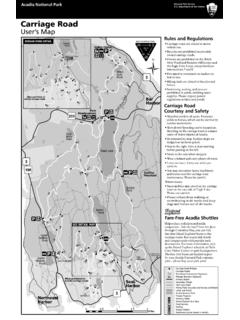Transcription of Driveway and Street Intersection Spacing TRC 456
1 Driveway and Street Intersection Spacing . - . - .. TRANSPORTATION RESEARCH BOARD / NATIONAL RESEARCH COUNCIL TRANSPORTATION RESEARCH CIRCULAR Number 456, March 1996 ISSN 0097-8515 Driveway AND Street Intersection Spacing COMMITTEE ON ACCESS MANAGEMENT Ronald K. Giguere, Chair Philip B. Demosthenes Arthur Jay Eisdorfer Jerry Gluck Dane Ismart Frank J. Koepke Douglas L. Landry Herbert S. Levinson William R. McShane Raymond D. Richter James A. Scott, TRB Staff Representative Subscriber category IVA Highway operations, capacity, and traffic control Eddie Shafie John L. Simon Gary Sokolow Vergil G. Stover Gail Yazersky-Ritzer Transportation Research Board National Research Council 2101 Constitution Avenue, Washington, 20418 The Transportation Research Boardis a unit of the National Research Council, which serves as an independent advisor to the federal government on scientific and technical questions of national importance.
2 The Research Council, jointly administered by the National Academy of Sciences, the National Academy of Engineering, and the Institute of Medicine, brings the resources of the entire scientific and technical community to bear on national problems through its volunteer advisory committees. FOREWORD This TRB Circular was developed by TRB's Committee on Access Management. A task force was organized to conduct the effort and was chaired by Jerry Gluck, Principal Associate, Urbitran. The committee recognized the lack of adequate guidelines for designing streets and highways from an access management perspective. The development of specific guidelines and standards was not attempted, but the task force has assembled examples of current practice that should be useful to highway agencies.
3 The task force has produced an excellent report through a volunteer effort, which is very much appreciated. Members of the task force included Philip B. Demosthenes, Salvatore J. Bellomo, Arthur Jay Eisdorfer, Ronald K. Giguere, Del Huntington, Frank J. Koepke, Dane Ismart, Gary Sokolow, and Vergil G. Stover. Additional TRB publication support was provided by James P. Douglas. DEDICATION This TRB Circular is dedicated to the memory of Dr. Salvatore J. Bellomo, , who passed away on June 7, 1994. Sal had a 30-year career filled with significant professional achievements and advanced the state of the art in many diverse areas of transportation planning. For his many accomplishments, he received the James Laurie Prize for professional contributions to the advancement of transportation engineering from the American Society of Civil Engineers.
4 In recent years, Sal was active in issues related to access management. He was the principal investigator of an FHWA project that developed guidelines for providing access to transportation systems and was the editor-in-chief of the Proceedings of the First National Access Managentent Confere~tce, held in Vail, Colorado, in 1993. He was a founding member of the TRB Committee on Access Management and a member of the task force that prepared this TRB Circular. Hugh McGee CONTENTS .. INTRODUCTION 5 Overview of Access Management .. 5 Access Management Benefits .. 5 Organization of Circular .. 9 .. GENERAL CONSIDERATIONS IN ESTABLISHING Spacing AND NUMBER OF DRIVEWAYS 11 .. Highwayperspective 11 .. Siteperspective 11 CONSIDERATIONS IN ESTABLISHING Spacing STANDARDS .. 12 Functional Classification.
5 12 Signalized Intersection Spacing .. 13 Functional Intersection Area .. 16 Unsignalized Intersection Spacing .. 21 REGULATIONS. POLICIES. AND STANDARDS FOR STATE HIGHWAY SYSTEMS .. 26 Interchanges .. 26 Signalized Intersection / Driveway Spacing .. 27 Unsignalized Intersection / Driveway Spacing .. 28 Median Openings .. 30 REGULATIONS. POLICIES. AND STANDARDS FOR LOCAL HIGHWAY SYSTEMS .. 33 Metropolitan Planning Organizations/Councils of Government .. 34 .. Counties 34 .. Cities 36 .. CONCLUSIONS 42 SELECTED REFERENCE DOCUMENTS .. 43 5 INTRODUCTION The Spacing of access for driveways and streets is an important element in the planning, design, and operation of roadways. Access points are the main source of accidents and congestion. Their location and Spacing directly affect the safety and functional integrity of streets and highways.
6 Too many closed spaced Street and Driveway intersections, for example, increase accident potential and delays and preclude effective traffic signal coordination. Too few inhibit access and over-concentrate traffic. Despite the importance of access Spacing for driveways and streets, it is often overlooked in current roadway and site planning efforts. Part of the problem stems from the constraints posed by existing streets and developments. However, the lack of sound Spacing standards and guidelines is an equal, if not more important, constraint. This circular on Driveway and Street Intersection Spacing has been developed in response to the need for information that may be applied in the development of sound Spacing practices. It is a compilation of the contemporary practice that illustrates the basic considerations for Spacing standards and guidelines and that describes current state, county, and local Spacing requirements.
7 OVERVIEW OF ACCESS MANAGEMENT Streets and highways constitute a valuable resource as well as a major public investment. It is essential to operate them safely and efficiently by managing the access to and from abutting properties. Owners have a right of reasonable access to the general system of streets and highways. Roadway users also have certain rights. They have the right to freedom of movement, safety, and efficient expenditure of public funds. The need to balance these competing rights is especially acute where significant changes to the transportation system and/or land use have occurred or are envisioned to occur. The safe and efficient operation of the transportation system calls for effectively managing the highway access, via driveways or streets, to adjacent developments.
8 This requires the proper Spacing of streets and driveways. Access management provides a systematic means of balancing the access and mobility requirement of streets and roads. Simply stated access management is the process that manages access to land development while simultaneously preserving the flow of traffic on the surrounding public road system in terms of safety, capacity, and speed. States ordinarily manage access through their police powers which enable them to regulate individual rights for the public welfare. Courts have generally upheld these police powers whenever reasonable access is maintained. The application of police powers to manage access must be part of a general policy and must be reasonably consistent. The key elements of a modern access management program involve: developing an access classification system; defining the allowable access level and access Spacing for each class of highway; providing a mechanism for granting variances when reasonable access cannot be provided; and establishing a means for enforcement of the program.
9 These requirements, along with appropriate design standards, are best included in an Access Code - such as those adopted in Colorado, Florida, and New Jersey. A comprehensive access code provides a predictable, systematic, supportable and equitable basis for making and enforcing access decisions. The specific techniques for managing access to developments involve the application of established traffic engineering and roadway design and planning principles that: Limit the number of conflicts, Separate basic conflict areas, Reduce interference with through traffic due to turns into or out of a site, Provide sufficient Spacing between at-grade intersections, Maintain progressive speeds along arterials, and Provide adequate on-site storage areas.
10 The application of these principles will minimize disruptions to the through traffic, caused by driveways and intersections. Their application will also ensure safe and efficient access to adjacent land developments. ACCESS MANAGEMENT BENEFITS Access management increases the Spacing and reduces the number and variety of events to which drivers must respond. This translates into fewer accidents, travel time savings, and preservation of capacity. These benefits are documented in information from a variety of sources. FIGURE 1 Accident redictions attributable to access management. "REGULAR" ARTERIALS OtoXQ 4toTP 6bIfS '12 CoISQ 16tolQQ MX=ESSFZO(HISPERM(~ FIGURE 2 Accident rates for road sections with different traffic volumes and access point frequencies. HIGHLY Safety Benefits Two decades of research have shown that managing access can significantly reduce the frequency and severity A Policy on Geometric of Highways and Streets of traffic accidents.))









